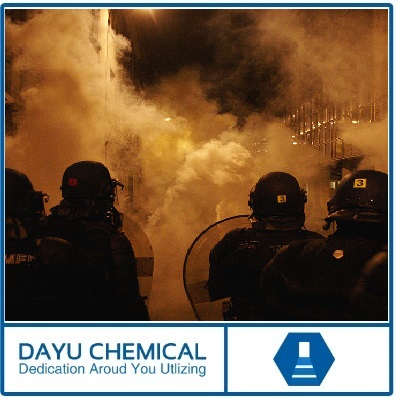Is CS gas dangerous? dayuchemical tell you
 May 23,2023
May 23,2023

CS gas (2-chlorobenzylidene malononitrile) is one of the most commonly used tear gases in the world.
Law enforcement agencies have found this agent invaluable when faced with combative suspects, for riot control, and for alleviating hostage and siege situations.
They use cs gas to help control individuals or groups without the need for lethal force.

At standard daily temperatures and pressures CS forms a white crystal with a low vapour pressure and poor solubility in water. CS aerosols thus act as a “powdered barb” with microscopic particles which are potent sensory irritants becoming attached primarily to moist mucous membranes and moist skin. The eye is the most sensitive organ in riot control because CS causes epiphora, blepharospasm, a burning sensation, and visual problems. Coughing, increased mucous secretion, severe headaches, dizziness, dyspnoea, tightness of the chest, difficulty breathing, skin reactions, and excessive salivation are common. The onset of symptoms occurs within 20 to 60 seconds, and if the exposed individual is placed in fresh air these findings generally cease in 10 to 30 minutes. In the main the medical literature supports the safety of CS gas.
This is especially true for ocular exposure. The current recommendations in Britain for treating ocular exposure are to “blow dry air directly onto the eye.”The recommendation of the manufacturers of CS in the United States is copious ocular irrigation to dislodge, dilute, and wash away the irritant. The US Army recommends flushing with water or saline and says that impact particles may need to be removed, although no impact CS particles have caused significant ocular damage.
This long-awaited report for the British government will not satisfy many because this issue has marked social and political overlay, and there is incomplete scientific data available to make comprehensive recommendations. Nevertheless, at this point, the committees' recommendations appear reasonable.
Based on our current knowledge, if CS tear gas is used by properly trained law enforcement officers and exposed combatants leave the area rapidly, few, if any, significant or long-term human disabling effects should occur.
 Tel: +86136 6925 2575
Tel: +86136 6925 2575 


 Home
Home During COVID-19, Offer 5 tons CS powder by dayuchemical
During COVID-19, Offer 5 tons CS powder by dayuchemical  You May Also Like
You May Also Like




 Tel
Tel
 Email
Email
 Address
Address








